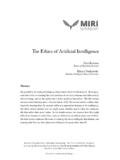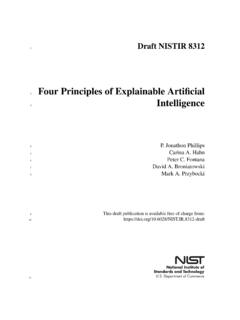Transcription of ARTIFICIAL INTELLIGENCE APPLICATION IN THE MILITARY
1 GLORIA SHKURTI ZDEMIRARTIFICIAL INTELLIGENCE APPLICATION IN THE MILITARY THE CASE OF UNITED STATES AND CHINAANALYSIS JUNE 2019 SHKURTI ZDEMIRARTIFICIAL INTELLIGENCE APPLICATION IN THE MILITARY THE CASE OF UNITED STATES AND CHINACOPYRIGHT 2019 by SETAAll rights part of this publication may be reprinted or reproduced or utilized in any form or by any electronic, mechanical or other means, without permission in writing from the : 978-605-7544-58-2 Printed in Turkey, stanbul by Turkuvaz Haberle me ve Yay nc l k A.., 2019 SETA | S YASET, EKONOM VE TOPLUM ARA TIRMALARI VAKFIN enehatun Cd. No: 66 GOP ankaya 06700 Ankara T RK YETel: +90 312 551 21 00 | Faks: +90 312 551 21 | | @setavakfiSETA | Washington 1025 Connecticut Avenue, , Suite 1106 Washington , 20036 USATel: 202-223-9885 | Faks: | | @setadcSETA | Kahire21 Fahmi Street Bab al Luq Abdeen Flat No: 19 Cairo EGYPTTel: 00202 279 56866 | 00202 279 56985 | @setakahireSETA | stanbulDefterdar Mh.
2 Savaklar Cd. Ayvansaray Kav a No: 41-43Ey psultan stanbul T RK YETel: +90 212 395 11 00 | Faks: +90 212 395 11 11 SETA | BerlinFranz sische Stra e 12, 10117 Berlin GERMANYTel: +49 30 INTELLIGENCE APPLICATION IN THE MILITARY : THE CASE OF UNITED STATES AND CHINATABLE OF CONTENTSABSTRACT 7 INTRODUCTION 8 UNDERSTANDING ARTIFICIAL INTELLIGENCE 9 WHY STATES INVEST IN ARTIFICIAL INTELLIGENCE 12 THE UNITED STATES AND ARTIFICIAL INTELLIGENCE 14 CHINA AND ARTIFICIAL INTELLIGENCE 18 CONCLUSION THE AUTHORG loria Shkurti zdemirGloria Shkurti completed her BA in Political Science and International Relations in Albania.
3 She finished her Master studies at Sakarya University with her thesis entitled A Lethal Weapon that Became the Cure-all for Terrorism: Discursive Construction of the Dronified Warfare. Currently, she is a candidate at Ankara Y ld r m Beyaz t University. Her main research interests include drone warfare, ARTIFICIAL INTELLIGENCE , foreign policy, and security studies. Currently, she is working as the Assistant to Editor-in-Chief of Insight Turkey, a journal pub-lished by SETA INTELLIGENCE APPLICATION IN THE MILITARY : THE CASE OF UNITED STATES AND CHINAABSTRACTC onsidered as the 4th Industrial Revolution, ARTIFICIAL INTELLIGENCE (AI) has become a reality in today s world, especially in the MILITARY . Experts and aca-demicians have emphasized the importance of AI for a long time. Further-more, world leaders, including Obama, Trump, Xi, and Putin, have all made important statements that bring to the fore the significance of AI which can be summarized with what Putin stated on September 2017: whoever be-comes the leader in AI, will rule the analysis provides a short introduction on what AI is, how it has evolved until today and how it will change the nature of warfare.
4 It then as-sesses why states invest in AI to later turn to the case of the and China. For both states, the main official documents and statements are analyzed, the bureaucratic structures that work on AI are presented and finally examples of how the and China are applying AI in the MILITARY are provided. The conclusion briefly comments on how the strategies of China and the differ followed by some recommendation on what states like Turkey should do in the near analysis provides a short introduction on what AI is, how it has evolved until today and how it will change the nature of warfare. It then assesses why states invest in AI to later turn to the case of the and INTELLIGENCE (AI) has advanced very quickly in recent years and this has resulted in a wide range of applications, both civil and MILITARY . It is a fact that the MILITARY is driven by the need for change as it is persistently on the pursuit of better, faster and stronger weapons or technolo-gies, and this is exactly what AI provides.
5 As is correctly stated by Svenmarck et al., in the field of MILITARY , AI has the potential to impact all do-mains ( land, sea, air, space and information) and all levels of warfare ( political, strategic, op-erational and tactical). 1 Currently, the use of AI in the MILITARY is seen mainly in terms of: Autonomous Weapons and Weapons Targeting Surveillance Cybersecurity Homeland Security Logistics Autonomous Vehicles21 Peter Svenmarck et al., Possibilities and Challenges for ARTIFICIAL In-telligence in MILITARY Applications, ( ), 1, Marcus Roth, ARTIFICIAL INTELLIGENCE in the MILITARY An Overview of Capabilities, Emerj, February 22, 2019, this reason, many state leaders, technol-ogy experts, and academicians have considered AI to be revolutionary; yet they differ in terms of their perspectives on AI. Specifically, some con-sider AI as a positive development as it would help in reducing human causalities -considering that the human force would be replaced by the machines which can be deployed in every kind of mission, including the high risk ones- and at the same time it would provide strategic and tactical advantages.
6 However, others caution on the fact that if not controlled and used properly, AI may result in another world though AI is still at its juvenile stage, it is undeniable that it has the capacity to alter the landscape of the security sector and as a result, it will change the current economic and MILITARY balances in the international system. Recogniz-ing the potentials of AI, more than 20 countries have announced their national AI strategies, and more states and non-state organization are taking decisive steps in AI research and devel-opment (R&D). Yet, the and China are considered to be the leading states in the field; the aiming to remain the hegemon in the battlefield, while China is aiming to leapfrog the and become the leader in AI by 2030. Needless to say, both these states have generat-ed independent national strategies that comply with these aims, but most importantly, the national strategy takes as its main reference point the Chinese national strategy, and vice versa.
7 This analysis provides a short introduction on what AI is, how it has evolved until today, and how it will change the nature of warfare. It then assesses why states invest in AI to later turn to the case of the and China. For both states, the main official documents and statements are ana-lyzed, the bureaucratic structures that work on AI are presented and examples are provided of how the and China are applying AI in the MILITARY . INTELLIGENCE APPLICATION IN THE MILITARY : THE CASE OF UNITED STATES AND CHINAIn the conclusion section, there is a brief comment on how the strategies of China and the dif-fer, followed by some recommendations on what states like Turkey should do in the near future. UNDERSTANDING ARTIFICIAL INTELLIGENCEC onsidered as the 4th Industrial Revolution,3 AI has become a reality in today s world and many experts argue that AI itself should not be consid-ered as a specific weapon but it should be seen as an enabler, a general-purpose technology with a multitude of applications.
8 4 So while AI could potentially enable a number of MILITARY in-novations, it is not a MILITARY innovation itself. 5 Kevin Kelly, a technology expert, compared AI with electricity stating that just as electricity brings objects all around us to life with power, so too will AI bring them to life with INTELLIGENCE . 6 However, technology experts are not the only ones that emphasize the importance of AI. World leaders, including Obama, Trump, Xi and Putin, have all made important statements that bring to the fore the significance of AI which can be summarized with what Putin stated on Sep-tember 2017: whoever becomes the leader in AI, will rule the has been developing since 1956, but in-terest in this field started to increase circa 2010 due to three enabling developments: (i) the avail-3 Paul Scharre, Army of None: Autonomous Weapons and the Future of War, Kindle Edition (New York, London: W.)
9 W. Norton & Company, 2018), 16; Klaus Schwab, The Fourth Industrial Revolution (Davos: World Eco-nomic Forum, 2016), Michael C. Horowitz, ARTIFICIAL INTELLIGENCE , International Competi-tion, and the Balance of Power, Texas National Security Review 1, no. 3 (May 2018): Horowitz, Scharre, Army of None: Autonomous Weapons and the Future of War, Whoever Leads in AI Will Rule the World : Putin to Russian Children on Knowledge Day, RT International, accessed April 21, 2019, of big data sources, (ii) improvements to machine learning approaches, and (iii) increases in computer processing Currently, we can speak about two types of AI: Narrow AI (NAI) and General AI (GAI). While NAI refers to functions like playing games or image recog-nition, GAI is used to denote systems capable of human-level INTELLIGENCE which are adequate to conduct a series of different tasks.
10 Currently, all the known AI developments fall within NAI while in terms of GAI, experts are generally skep-tical and it is believed that decades are needed until it reaches its full Yet in order to understand better, this classification is not important. An important issue related to AI, re-gardless of whether it is narrow or general, is that of the autonomy. The next subsection provides a brief outline in terms of the spectrum of au-tonomy which results from the use of AI. Types of Autonomy: Human-Machine RelationshipWhen it comes to the APPLICATION of AI, especially in the MILITARY , the human-machine relationship is one of the main topics discussed. Currently, there are three types of relationships that we can debate about: (i) human in the loop, (ii) human on the loop, and (iii) human out of the loop. When the human is in the loop it means that the machine is in the control of the environment; however, it is the human that takes the final deci-sion.







